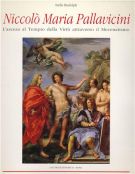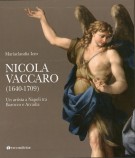Genovese di nascita ma cosmopolita per educazione, il marchese Pallavicini (1650-1714) fu banchiere di leggendaria ricchezza e insigne mecenate in Roma ove, entro la fine del Seicento, la sua collezione, era segnalata come la più notevole tra le recenti. Oltre al nucleo dei capolavori di Annibale Carracci, Andrea Sacchi, Pietro da Cortona e Claude Lorrain, la quadreria comprendeva centinaia di nature morte (Berentz, Van Vogelaer, Van Tamm), paesaggi (Dughet, Van Bloemen) e dipinti di soggetto storico, che rappresentavano le più aggiornate tendenze nella pittura romana capeggiata dal suo amico Carlo Maratti.
Altrettanto celebre era l’arredo del suo palazzo, per la dovizia delle stoffe genovesi, le sculture di Camillo Rusconi e l’impareggiabile raccolta degli argenti di Giovanni Giardini. I tesori del Pallavicini, furono contesi ed incamerati nel Settecento dai maggiori collezionisti inglesi e da sovrani (Federico II di Prussia e Caterina II di Russia) complici, gli illustri intermediari dell’epoca (Gavin Hamilton, Mengs, Conte Algarotti, Horace Walpole). La storia della formazione e della diaspora della raccolta del Pallavicini è qui ricostruita, per la prima volta, con l’ausilio di un vasto gruppo di documenti inediti, che contribuiscono a fare chiarezza su una personalità eccentrica versata in alchimia e lettere, arcade e prototipo del Virtuoso e Dilettante alle soglie dell’epoca dei lumi. Si tratta del tassello mancante nella vicenda del mecenatismo romano fra tardobarocco e rococo, che ebbe uno strascico importante per il collezionismo europeo del Settecento. Il volume è arricchito dalle appendici documentarie, da un apparato illustrativo di opere non note e altre di cui si ignorava la provenienza.
Of Genovese birth and endowed with a cosmopolitan education, the Marchese [Marquis] Pallavicini (1650-1714) became a banker of legendary wealth and one of Rome’s most eminent patrons. By the late seventeenth century his collection was distinguished as the finest of its day. Alongside its nucleus of masterpieces by Annibale Carracci, Andrea Sacchi, Pietro da Cortona and Claude Lorrain, his collection boasted hundreds of still-life paintings (including works by Berentz, Van Vogelaer and Van Tamm), landscapes (by Dughet and Van Bloemen) and history paintings representing the most up-to-the-minute tendencies of the Roman school led, by Pallavicini’s learned friend Carlo Maratti.
His palazzo was equally celebrated for its spectacular furnishing with an abundance of Genovese fabric, sculptures by Camillo Rusconi, and an unrivalled collection of silver-ware by Giovanni Giardini. Subsequently, with the complicity of the most internationally illustrious intermediaries (Gavin Hamilton, Anton Raphael Mengs, Count Francesco Algarotti and Sir Horace Walpole), Niccolò Maria Pallavicini’s treasures were to be contested and collected by and the leading British collectors of the eighteenth century as well as sovereigns such as Frederick II of Prussia and Catherine II of Russia. In this study the history of the formation and dispersion of the Pallavicini collection is reconstructed for the first time with the aid of a significant body of previously unpublished documents. It sheds light on this eccentric personality, versed in alchemy as well as letters, who was a member of the Accademia degli Arcadi and an exemplary proto-enlightenment model of the eighteenth century Virtuoso and Dilettante. As such, Pallavicini is seen to typify the main traits of roman patronage in the late baroque and rococo era, while representing an influential individual style that was to impact significantly on European collecting habits during the eighteenth century. This 250 page volume is enriched by documentary appendices and 160 colour and black and white illustrations many of little known works and many previously divorced from their provenance.
Note alle condizioni del volume
Nessuna. (T-CA)
Potrebbero interessarti anche...





